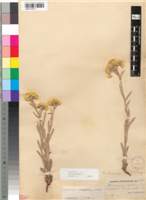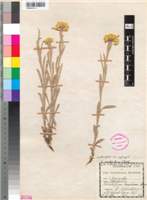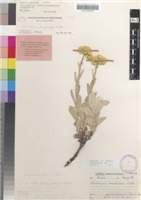Origin of name:
oreophilum = mountain loving
Diagnostic characters:
Bright yellow bractsLarge headsCompact branched inflorescence
Description:
Perennial herb with a woody branching rhizome, flowering stems erect to c. 300 mm, simple, thinly grey silky-woolly, leafy. Leaves up to 80 x 15 mm, progressively smaller upwards, oblanceolate becoming lanceolate upwards, apex acute, base half-clasping, both surfaces grey silky-woolly, generally only the main nerve visible below. Heads homogamous, turbinate-campanulate, c. 7 x mm, several to many in a compact corymbose panicle. Involucral bracts in c. 5 series, subequal, loosely imbricate, cobwebby at base, tips acute, slightly exceeding the flowers, not radiating, lemon-yellow. Receptacle honeycombed. Flowers 9�12. Achenes c. 1.25 mm long, with myxogenic duplex hairs. Pappus bristles many, about equaling corolla, scabrid, bases cohering strongly by patent cilia, some light fusion as well.
Flowers mainly between October and December.
Distribution:
Grows in grassland and readily invades overgrazed and eroded areas. Ranges from the E. highlands of the Limpopo and Mpumalanga, the Witwatersrand and Suikerbosrand to the mountains in Swaziland, the low Drakensberg on the Mpumalanga-KwaZulu-Natal border, the mountainous NE. corner of the Free State, and the KwaZulu-Natal Drakensberg and its foothills and outliers.
Grassland Biome.
Taxonomy:
Literature:
Helichrysum oreophilum Klatt in Bull. Herbarium Boissier 4: 837 (1896); Moeser in Bot. Jb. 44: 276 (1910); Compton, Fl. Swaziland 632 (1976); Hilliard, Compositae in Natal 196 (1977).
Type:
Lectotype: Transvaal, Klein Olifantsrivier, Schlechter 3805 (Z; K; PRE, isolecto.).
Synonym(s):
Vouchers:
Bremer 605 (NU); Codd 3131 (NU; PRE); Hilliard 1020 (NU); Wright 286 (E; NU).

_sml.jpg)
_sml.jpg)
_sml.jpg)
_sml.jpg)
_sml.jpg)



